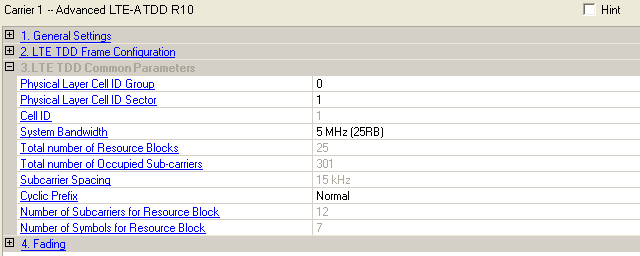
These first three groups of settings apply to all basic and advanced carriers. The Fading parameters are available for Advanced LTE and Advanced LTE-A TDD carriers only.
Some parameters do not apply to the Basic LTE PRACH and Basic LTE-A PRACH.

Range: 0 to 167
Default: 0
Enter a value for the physical layer cell ID group. The combination of one Physical Layer Cell ID Group value and one Physical Layer Cell ID Sector value determines a unique physical layer cell ID.
There are 504 unique physical-layer cell identities. The physical-layer
cell identities are grouped into 168 unique physical-layer cell-identity
groups, each group containing three unique identities. The grouping is
such that each physical-layer cell identity is part of one and only one
physical-layer cell-identity group. A physical-layer cell identity  is thus uniquely
defined by a number
is thus uniquely
defined by a number  in
the range of 0 to 167, representing the physical-layer cell-identity group,
and a number
in
the range of 0 to 167, representing the physical-layer cell-identity group,
and a number  in the range of 0 to 2, representing the physical-layer
identity within the physical-layer cell-identity group.
in the range of 0 to 2, representing the physical-layer
identity within the physical-layer cell-identity group.
Choice: 0 | 1 | 2
Default: 0
Double-click or use the drop down menu to set the physical layer cell ID sector. The combination of one Physical Layer Cell ID Group value and one Physical Layer Cell ID Sector value determines a unique physical layer cell ID.
Refer to 3GPP TS36.211.
Range: 0 to 503
Default: 0
Enter the value for the Cell ID. The combination of one Physical Layer Cell ID Group value and one Physical Layer Cell ID Sector value determines a unique physical layer Cell ID.
Cell ID = Physical Layer Cell ID Group *3 + Physical Layer Cell ID Sector
Refer to 3GPP TS36.211.
Choice: 1.4 MHz (6RB) | 3 MHz (15RB) | 5 MHz (25RB)) | 10 MHz (50RB) | 15 MHz (75RB) | 20 MHz (100RB)
Default:
LTE: 5 MHz (25RB)
LTE-A: 10 MHz (50RB)
Double-click or use the drop-down menu to set the system bandwidth and number of resource blocks (RB). When you select a system bandwidth, the software automatically adjusts the values in the Total Number of Resource Blocks and Total Number of Occupied Sub-carriers cells.
Advanced LTE and LTE-A carriers only: When the system bandwidth is decreased, the DL-SCH Tx Sequence window's RB size, and some of the other data channel's settings, are reconfigured, similar to when a predefined configuration is executed. But, when the system bandwidth is increased, no change to the DL-SCH Tx Sequence window's RB size, or the other data channel's settings occurs.
The value in this cell is set by the software based on the System Bandwidth setting.
The value in this cell is set by the software based on the System Bandwidth setting. The center subcarrier is not used for downlink transmission, so the number of transmitted subcarriers is one less than the number of occupied subcarriers.
Default: 15 KHz
Displays the subcarrier spacing.
Choice: Normal | Extended
Default: Normal
Coupling: For Basic, Advanced UL, and Advanced DL LTE-A TDD when Auto Carrier Aggregation Configuration is set to On, this setting is read only for the secondary cells that has the same value as the primary cell.
Double-click or use the drop-down menu to select a Normal or Extended cyclic prefix. The software sets the Number of Symbols for Resource Block based on the cyclic prefix selection.
Default: 12
Displays the number of consecutive subcarriers in a resource block.
Default: 7 (Normal CP); 6 (Extended CP)
Displays the number of consecutive OFDM symbols in a slot.